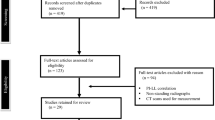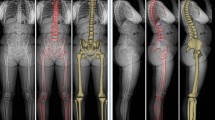Abstract
Purpose
Pelvic incidence is a position- and posture-independent parameter used to quantify sagittal balance of the spine, sacrum, pelvis and hips. Its functional consequences have been associated with a number of different pathologies of the spine. However, there exists considerable controversy over which demographic features contribute to the development of pelvic incidence.
Methods
880 cadaveric skeletons from the Hamann-Todd Osteological Collection were obtained. The innominate bones and sacrum were reconstructed, and pelvic incidence was measured using a previously validated technique. Specimens with obvious fracture, infection, or rheumatologic conditions were excluded from study. Descriptive data of age at the time of death, gender, race and height were collected.
Results
The average pelvic incidence was 46.0° ± 11.0°. Pelvic incidence did not change with age (r = 0.026, p = 0.288). There was no difference in pelvic incidence measurements between females and males (47.2° ± 13.8° vs. 45.8° ± 10.4°, respectively; p = 0.257), although this analysis was under-powered. Pelvic incidence was higher in African-Americans compared to Caucasians (48.9° ± 11.0° vs. 44.9° ± 10.8°; p = 0.001). There was no association between height and pelvic incidence (r = −0.042, p = 0.164).
Conclusions
This study represents the largest single cohort of pelvic incidence measurements reported in the literature. Our data suggest that pelvic incidence does not change with age or height, although racial differences do exist. As spine care providers increasingly rely on pelvic incidence as an important means to quantify sagittal balance, the normative data provided herein will provide an essential reference.



Similar content being viewed by others
References
Duval-Beaupere G, Schmidt C, Cosson P (1992) A Barycentremetric study of the sagittal shape of spine and pelvis: the conditions required for an economic standing position. Ann Biomed Eng 20:451–462
Legaye J, Duval-Beaupere G, Hecquet J, Marty C (1998) Pelvic incidence: a fundamental pelvic parameter for three-dimensional regulation of spinal sagittal curves. Eur Spine J 7:99–103
Huang RP, Bohlman HH, Thompson GH, Poe-Kochert C (2003) Predictive value of pelvic incidence in progression of spondylolisthesis. Spine 28:2381–2385
Lonner BS, Auerbach JD, Sponseller P, Rajadhyaksha AD, Newton PO (2010) Variations in pelvic and other sagittal spinal parameters as a function of race in adolescent idiopathic scoliosis. Spine (Phila Pa 1976) 35:E374–E377. doi:10.1097/BRS.0b013e3181bb4f96
Janssen MM, Drevelle X, Humbert L, Skalli W, Castelein RM (2009) Differences in male and female spino-pelvic alignment in asymptomatic young adults: a three-dimensional analysis using upright low-dose digital biplanar X-rays. Spine (Phila Pa 1976) 34:E826–E832. doi:10.1097/BRS.0b013e3181a9fd85
Barrey C, Jund J, Noseda O, Roussouly P (2007) Sagittal balance of the pelvis-spine complex and lumbar degenerative diseases. A comparative study about 85 cases. Eur Spine J Off Publ Eur Spine Soc Eur Spinal Deform Soc Eur Sect Cerv Spine Res Soc 16:1459–1467. doi:10.1007/s00586-006-0294-6
Boulay C, Tardieu C, Hecquet J, Benaim C, Mouilleseaux B, Marty C, Prat-Pradal D, Legaye J, Duval-Beaupère G, Pélissier J (2006) Sagittal alignment of spine and pelvis regulated by pelvic incidence: standard values and prediction of lordosis. Eur Spine J 15:415–422
Vaz G, Roussouly P, Berthonnaud E, Dimnet J (2002) Sagittal morphology and equilibrium of pelvis and spine. Eur Spine J Off Publ Eur Spine Soc Eur Spinal Deform Soc Eur Sect Cerv Spine Res Soc 11:80–87
Vrtovec T, Janssen M, Likar B, Castelein RM, Viergever MA, Pernuš F (2012) A review of methods for evaluating the quantitative parameters of sagittal pelvic alignment. Spine J 12:433–446
Kopydlowski NJ, Tannenbaum EP, Bedi A, Smith MV, Sekiya JK (2014) An increase in cranial acetabular version with age: implications for femoroacetabular impingement. J Arthroplast 29:1741–1744. doi:10.1016/j.arth.2014.03.042
Tannenbaum E, Kopydlowski N, Smith M, Bedi A, Sekiya JK (2014) Gender and racial differences in focal and global acetabular version. J Arthroplast 29:373–376. doi:10.1016/j.arth.2013.05.015
Gebhart JJ, Streit JJ, Bedi A, Bush-Joseph CA, Nho SJ, Salata MJ (2014) Correlation of pelvic incidence with cam and pincer lesions. Am J Sports Med. doi:10.1177/0363546514548019
Maruyama M, Feinberg JR, Capello WN, D’Antonio JA (2001) The Frank Stinchfield Award: morphologic features of the acetabulum and femur: anteversion angle and implant positioning. Clin Orthop Relat Res. 52–65
Fleiss JL, Levin B, Paik MC (2013) Statistical methods for rates and proportions. Wiley
Levine M, Ensom MH (2001) Post hoc power analysis: an idea whose time has passed? Pharmacother J Human Pharmacol Drug Ther 21:405–409
Schwab F, Lafage V, Patel A, Farcy JP (2009) Sagittal plane considerations and the pelvis in the adult patient. Spine (Phila Pa 1976) 34:1828–1833. doi:10.1097/BRS.0b013e3181a13c08
Mac-Thiong JM, Labelle H, Berthonnaud E, Betz RR, Roussouly P (2007) Sagittal spinopelvic balance in normal children and adolescents. Eur Spine J Off Publ Eur Spine Soc Eur Spinal Deform Soc Eur Sect Cerv Spine Res Soc 16:227–234. doi:10.1007/s00586-005-0013-8
Lafage R, Ferrero E, Henry JK, Challier V, Diebo B, Liabaud B, Lafage V, Schwab F (2015) Validation of a new computer-assisted tool to measure spino-pelvic parameters. Spine J. doi:10.1016/j.spinee.2015.08.067
Maillot C, Ferrero E, Fort D, Heyberger C, Le Huec JC (2015) Reproducibility and repeatability of a new computerized software for sagittal spinopelvic and scoliosis curvature radiologic measurements: keops((R)). Eur Spine J Off Publ Eur Spine Soc Eur Spinal Deform Soc Eur Sect Cerv Spine Res Soc 24:1574–1581. doi:10.1007/s00586-015-3817-1
Gebhart JJ, Streit JJ, Bedi A, Bush-Joseph CA, Nho SJ, Salata MJ (2014) Correlation of pelvic incidence with cam and pincer lesions. Am J Sports Med 42:2649–2653
Gebhart JJ, Bohl MS, Weinberg DS, Cooperman DR, Liu RW (2014) Pelvic incidence and acetabular version in slipped capital femoral epiphysis. J Pediatr Orthop. doi:10.1097/bpo.0000000000000342
Peleg S, Dar G, Medlej B, Steinberg N, Masharawi Y, Latimer B, Jellema L, Peled N, Arensburg B, Hershkovitz I (2007) Orientation of the human sacrum: anthropological perspectives and methodological approaches. Am J Phys Anthropol 133:967–977. doi:10.1002/ajpa.20599
Dimar JR 2nd, Carreon LY, Labelle H, Djurasovic M, Weidenbaum M, Brown C, Roussouly P (2008) Intra- and inter-observer reliability of determining radiographic sagittal parameters of the spine and pelvis using a manual and a computer-assisted methods. Eur Spine J Off Publ Eur Spine Soc Eur Spinal Deform Soc Eur Sect Cerv Spine Res Soc 17:1373–1379. doi:10.1007/s00586-008-0755-1
Portinaro N, Murray D, Bhullar T, Benson M (1995) Errors in measurement of acetabular index. J Pediatr Orthopa 15:780–784
Pfirrmann CW, Resnick D (2001) Schmorl nodes of the thoracic and lumbar spine: radiographic-pathologic study of prevalence, characterization, and correlation with degenerative changes of 1650 spinal levels in 100 cadavers 1. Radiology 219:368–374
Wetherell R, Amis A, Heatley F (1989) Measurement of acetabular erosion. The effect of pelvic rotation on common landmarks. J Bone Joint Surg Br 71:447–451
Mac-Thiong J-M, Berthonnaud É, Dimar JR, Betz RR, Labelle H (2004) Sagittal alignment of the spine and pelvis during growth. Spine 29:1642–1647
Mangione P, Gomez D, Senegas J (1997) Study of the course of the incidence angle during growth. Eur Spine J 6:163–167
Shah SA, Karatas AF, Dhawale AA, Dede O, Mundis GM Jr, Holmes L Jr, Yorgova P, Neiss G, Johnston CE, Emans JB, Thompson GH, Pawelek JB, Akbarnia BA (2014) The effect of serial growing rod lengthening on the sagittal profile and pelvic parameters in early-onset scoliosis. Spine (Phila Pa 1976) 39:E1311–E1317. doi:10.1097/brs.0000000000000565
Mendoza-Lattes S, Ries Z, Gao Y, Weinstein SL (2010) Natural history of spinopelvic alignment differs from symptomatic deformity of the spine. Spine (Phila Pa 1976) 35:E792–E798. doi:10.1097/BRS.0b013e3181d35ca9
Hanson DS, Bridwell KH, Rhee JM, Lenke LG (2002) Correlation of pelvic incidence with low- and high-grade isthmic spondylolisthesis. Spine (Phila Pa 1976) 27:2026–2029
Mac-Thiong JM, Roussouly P, Berthonnaud E, Guigui P (2010) Sagittal parameters of global spinal balance: normative values from a prospective cohort of seven hundred nine Caucasian asymptomatic adults. Spine (Phila Pa 1976) 35:E1193–E1198. doi:10.1097/BRS.0b013e3181e50808
Vialle R, Levassor N, Rillardon L, Templier A, Skalli W, Guigui P (2005) Radiographic analysis of the sagittal alignment and balance of the spine in asymptomatic subjects. J Bone Joint Surg Am 87:260–267. doi:10.2106/jbjs.d.02043
Amonoo-Kuofi HS (1992) Changes in the lumbosacral angle, sacral inclination and the curvature of the lumbar spine during aging. Acta Anat (Basel) 145:373–377
Jackson RP, Peterson MD, McManus AC, Hales C (1998) Compensatory spinopelvic balance over the hip axis and better reliability in measuring lordosis to the pelvic radius on standing lateral radiographs of adult volunteers and patients. Spine (Phila Pa 1976) 23:1750–1767
Hays WL (1973) Statistics for the social sciences. Holt, Rinehart and Winston, New York
Von Lackum H (1924) The lumbosacral region: an anatomic study and some clinical observations. J Am Med Assoc 82:1109–1114
Fernand R, Fox DE (1985) Evaluation of lumbar lordosis. A prospective and retrospective study. Spine (Phila Pa 1976) 10:799–803
Mosner EA, Bryan JM, Stull MA, Shippee R (1989) A comparison of actual and apparent lumbar lordosis in black and white adult females. Spine (Phila Pa 1976) 14:310–314
Acknowledgments
The authors would like to thank Yohannes Haile-Selassie, PhD; Lyman Jellema, MS, at the Cleveland Museum of Natural History for help with obtaining specimens.
Author information
Authors and Affiliations
Corresponding author
Ethics declarations
Conflict of interest
The authors report no conflict of interest.
Electronic supplementary material
Below is the link to the electronic supplementary material.
Rights and permissions
About this article
Cite this article
Weinberg, D.S., Morris, W.Z., Gebhart, J.J. et al. Pelvic incidence: an anatomic investigation of 880 cadaveric specimens. Eur Spine J 25, 3589–3595 (2016). https://doi.org/10.1007/s00586-015-4317-z
Received:
Revised:
Accepted:
Published:
Issue Date:
DOI: https://doi.org/10.1007/s00586-015-4317-z




